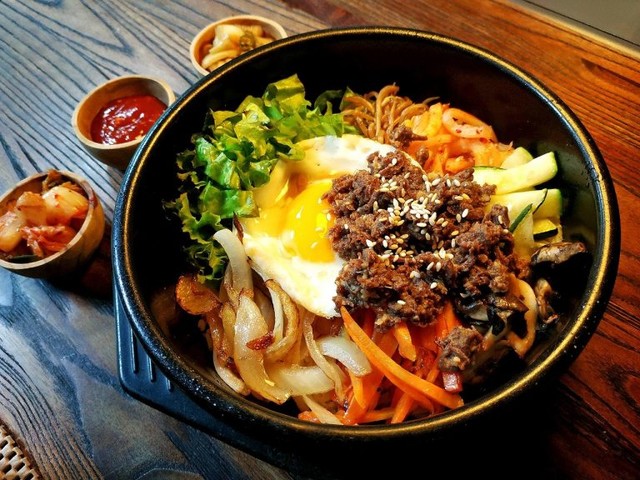According to The Chosun Daily, foreigners are increasingly fond of Korean cuisine (K-food) and there is a grow...
According to The Chosun Daily, foreigners are increasingly fond of Korean cuisine (K-food) and there is a growing trend of returning to Seoul.
Development trend of K-food in South Korea
Tourism experts believe that K-food has become a prevailing trend in South Korea, surpassing the popularity of K-pop (Korean music) or K-drama (Korean dramas).
 How South Korea attracts foreign tourists back through K-food is an experience for Vietnam to learn from - Illustration. Source: Travel Food Atlas
How South Korea attracts foreign tourists back through K-food is an experience for Vietnam to learn from - Illustration. Source: Travel Food Atlas
In a recent survey by the Seoul Tourism Organization (STO), among 500 foreigners who wanted to return to Seoul more than twice in the second half of 2023, the top reason they cited was delicious food (scoring 75.9 points), followed by ample shopping opportunities (73.2 points), pleasant weather (72.9 points), and countless sightseeing spots to enjoy (72.7 points).
"Tourists returning to South Korea two or three times because they love Korean cuisine has surprised us," commented Kil Ki-yon, head of the STO.
The STO also provided an analysis of the dining expenses of foreign visitors to Seoul last year. The results showed that their favorite dishes were galbi (grilled ribs) and samgyeopsal (grilled pork belly), accounting for 41.5% of their choices. Next were chicken (7.7%), desserts (6.3%), and beer (5.7%).
"Recently, menu choices for Korean cuisine have been expanded, with dishes like oysters, strawberries, peanuts, and ramen becoming increasingly popular," noted an STO representative.
Food preferences also vary among people from different countries. For example, Japanese tourists often allocate a significant portion of their dining budget to desserts, gejang (live raw crab marinated in soy sauce or chili sauce), or visiting izakayas (Japanese pubs).
Mr. Hayama Kazuyo (50 years old, from Nagoya) has visited South Korea for tourism more than 40 times. On each visit, he always enjoys gejang.
"Finding gejang in Japan is quite difficult and the prices are usually over 10,000 yen (about 90,000 won) per person. In Korea, you can eat to your heart's content for just 50,000 won per person, making me feel wealthy," said Mr. Hayama Kazuyo.
Chinese tourists also express their culinary preferences in South Korea. At a Chinese restaurant in Jung-gu district (Seoul) on February 15, more than half of the customers were tourists from China and Taiwan.
"I was very surprised after trying the black bean noodles jajangmyeon. The taste is completely different from our zhajiangmian. It's dark and sweet. This is not Chinese cuisine. It's Korean-style food," said Ms. Su Yuqi (32 years old) from Taiwan (China) expressing her surprise and sharing.
Black bean noodles are called "zha jiang mien" in Chinese and "jajangmyeon" in Korean. Additionally, many Chinese tourists also enjoy gamja-tang (pork spine stew) here.
When in South Korea, many tourists from Southeast Asia also have a preference for dak-galbi (spicy stir-fried chicken) and gopchang (grilled beef intestines).
"We also really enjoy dishes made from chicken innards in the Philippines. I have no hesitation in trying dishes like gopchang in Seoul," said Marian Bautista (20 years old), a tourist from the Philippines.
The spread of Korean cuisine
The heat of the Hallyu wave has rapidly spread K-Food on the global culinary map. Korean dishes are becoming more popular and beloved by many diners worldwide. Based on meticulous studies of the characteristics and culinary styles of local people, Korean culinary producers have diversified products in restaurants, eateries, and packaged foods, contributing to the rapid development of K-Food.
A survey conducted by the Seoul Business Agency (SBA) with the participation of 128 influential individuals who had visited Seoul before was also carried out.
The results showed that the aspect they were most satisfied with in Seoul was food (22.1%). Next were the environment (13.9%) and shopping opportunities (13.9%). The culinary criterion always ranks first on the list, surpassing other factors such as Hallyu culture, including K-pop, safety levels, and shopping needs.
The most popular dish that tourists choose when in Seoul is tteokbokki (rice cakes - 13.8%), followed by samgyeopsal (12.2%), bibimbap (11.4%), and bulgogi (marinated grilled beef, 8.1%). According to an SBA official, because most ordinary tourists are aged 20 and 30, mainly women, it seems that tteokbokki is very popular.
For a long time, dishes like tteokbokki have become beloved symbols of Korean cuisine by international audiences.
Professor Seo Won-seok from the Graduate School of Tourism at Kyung Hee University emphasized that Korean cuisine (K-pop) has brought more accessible and addictive experiences compared to K-pop or K-drama.
Meanwhile, Professor Lee Hoon from the Department of Tourism at Hanyang University believed that in the era of social media tourism, experiential destinations are extremely important. At these destinations, individuals often try to immerse themselves in the daily lives of locals, share photos. Culinary tourism emerges as an essential activity for those desires. Therefore, this is also the reason why Korean culinary tourism has risen and spread worldwide.
Via To quoc